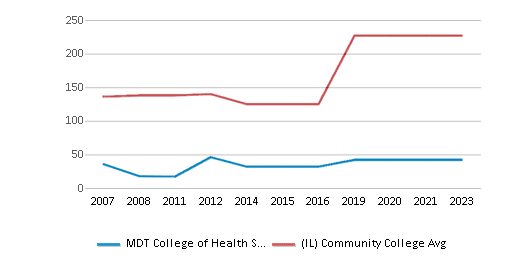- The mission of ATS Institute of Technology is to create and provide a high quality educational experience to each individual student seeking to establish a successful career. The college is committed to offering health care programs designed to satisfy local and regional demands and equip students with a wide range of academic knowledge.
School Highlights
MDT College of Health Sciences serves 613 students (60% of students are full-time).
The college's student:teacher ratio of 15:1 is lower than the state community college average of 21:1.
Minority enrollment is 98% of the student body (majority Black), which is more than the state average of 53%.
Quick Stats (2025)
- Enrollment: 613 students
- Private-state tuition: $23,162
- Acceptance Rate: 84%
- Student:teacher ratio: 15:1
- Minority enrollment: 98%
- Source: Integrated Postsecondary Education Data System (IPEDS)
Top Rankings
MDT College of Health Sciences ranks among the top 20% of public schools in Illinois for:
Category
Attribute
School Resources
School Overview
The teacher population of 42 teachers has stayed relatively flat over five years.
MDT College of Health Sciences
(IL) Community College Avg.
Carnegie Classification
Not applicable, not in Carnegie universe (not accredited or nondegree-granting)
Associate's Colleges: Mixed Transfer/Career & Technical-High Nontraditional
Institution Level
Less than 2 years (below associate)
At least 2 but less than 4 years
Institution Control
Private for-profit
Public
Total Faculty
42 staff
227 staff

Student Body
The student population of MDT College of Health Sciences has grown by 93% over five years.
The student:teacher ratio of 15:1 has increased from 6:1 over five years.
The MDT College of Health Sciences diversity score of 0.17 is less than the state average of 0.69. The school's diversity has grown by 11% over five years.
Total Enrollment
613 students
3,270 students

Student : Teacher Ratio
15:1
21:1

# Full-Time Students
370 students
1,007 students

# Part-Time Students
243 students
2,747 students



# Enrollment Undergraduate
613 students
328 students
# Full-Time Undergraduate Students
370 students
1,007 students

# Full-Time Graduate Students
n/a
43 students
# Part-Time Undergraduate Students
243 students
3,310 students
# Part-Time Graduate Students
n/a
18 students
Total Dormitory Capacity
n/a
132 students
% Asian
1%
6%

% Hispanic
2%
26%

% Black
91%
13%

% White
2%
47%

% Two or more races
1%
3%

% Non Resident races
n/a
1%
% Unknown races
2%
4%


Diversity Score
0.17
0.69

College Completion Rate (Students who graduate in less than 4 years)
0.3333%
0.4%

College Completion Rate (Students who graduate in 4 years or more than 4 years)
n/a
0.38%
Average Graduate Earnings (10 Years)
$26,400
$31,800

Tuition and Acceptance Rate
The private state tuition of $23,162 is more than the state average of $14,511. The private state tuition has grown by 17% over four years.
Private State Tuition Fees
$23,162
$14,511

% Students Receiving Some Financial Aid
100%
82%

Median Debt for Graduates
$19,612
$8,187

Median Debt for Dropouts
$9,500
$4,618

Acceptance Rate
84%
89%

SAT Reading
n/a
390
SAT Math
n/a
360
SAT Writing
n/a
355
ACT Composite
n/a
17
ACT English
n/a
17
ACT Math
n/a
17
Source: 2024 (or latest year available) Integrated Postsecondary Education Data System (IPEDS)
Frequently Asked Questions
How much does MDT College of Health Sciences cost?
MDT College of Health Sciences's private state tuition is approximately $23,162.
What is the acceptance rate of MDT College of Health Sciences?
The acceptance rate of MDT College of Health Sciences is 84%, which is lower than the state average of 89%.
What is MDT College of Health Sciences's ranking?
MDT College of Health Sciences ranks among the top 20% of community college in Illinois for: Average community college minority breakdown and Percent of students receiving financial aid.
Recent Articles

Obtaining Your Bachelor's Degree at a Community College
Explore the evolving landscape of community colleges offering bachelor's degrees, addressing affordability, accessibility, and workforce needs.

A to Z of Community College Certificates and Courses
From business and healthcare to technology and skilled trades, the article showcases the breadth of options available to students seeking to enhance their knowledge, develop new skills, or pursue career advancement.

What is a Community College?
This comprehensive guide explains what a community college is, its history, and its role in higher education. It covers the types of programs offered, differences from four-year colleges, benefits of attending, and important considerations for prospective students, providing valuable insights for those exploring educational options.





